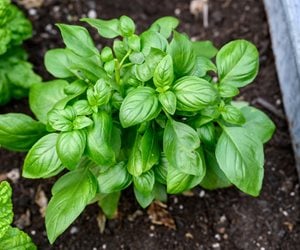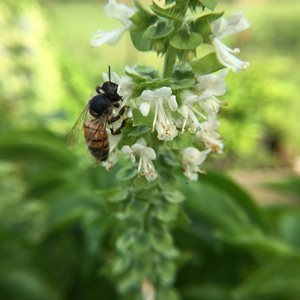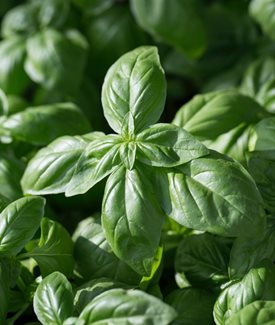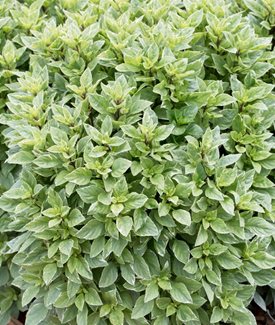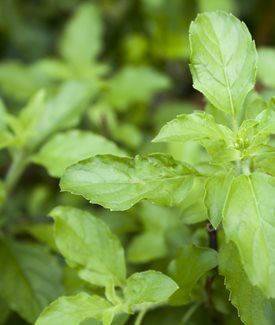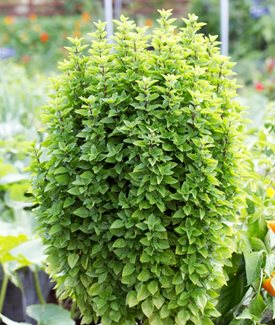GROWING AND USING BASIL
Plant, harvest and cook with this essential kitchen herbOne of the most widely used herbs in the world, basil is renowned from India to Italy for an array of culinary and medicinal purposes. The highly aromatic leaves are an essential seasoning in many popular cuisines including Italian, Thai, and Vietnamese. Known for its health and nutritional benefits, basil is an important source of vitamins, trace minerals, and antioxidants.
A member of the mint family (Lamiaceae), basil is typically grown as an annual, but may overwinter in warmer zones. Sweet basil is the type most commonly grown by home gardeners, though there are others with flavors ranging from lemon to cinnamon.
On this page: Basics | Planting | Care | Choosing the Right Basil | Basil Varieties | Problems and Troubleshooting
- BASIL BASICS
- PLANTING INSTRUCTIONS
- BASIL CARE
- HOW TO CHOOSE THE RIGHT BASIL
- BASIL VARIETIES
- PROBLEMS AND TROUBLESHOOTING
BASICS
Botanical name:
Ocimum
Zones:
10-11, usually grown as an annual
Height/Spread:
Upright, mounding or spreading habit; 6 to 48 inches tall and 6 to 36 inches wide.
Exposure:
Full sun; some afternoon shade in hot climates
Bloom time:
Summer to frost
Color and characteristics:
This tender tropical herb is grown for its fragrant edible foliage. Round or pointed leaves are green, purple, or variegated; ¼ to 4 inches long, with smooth or crinkled texture. Erect, branching stems are green or purple. Vertical flower spikes are white, lavender, or purple, with dozens of tiny tubular blooms up and down the stem. Flavor is generally sweet, with hints of anise, licorice, lemon, lime, cinnamon, clove, or overall spiciness.
Toxicity:
All parts of the basil plant are safe for pets and can provide dietary benefits. Ingesting too much of any fibrous plant can result in gastrointestinal upset for some dogs and cats. In rare instances, some pets may be allergic to basil.
PLANTING INSTRUCTIONS
Basil can be grown in raised beds, garden beds, containers, or in mixed herb gardens. Beginning in mid-to-late spring, mail order and retail nurseries sell tray packs, 4-inch, or gallon-sized plant starts—the most common way to add it to your garden.
When to plant:
Basil is a heat lover and susceptible to problems if cold stressed. Wait until late spring to early summer when temperatures are consistently in the 70s during the day and over 50 degrees F at night.
Where to plant:
Choose a sunny, hot site that gets at least 6 to 8 hours of direct sun; provide some afternoon shade in hot climates. Plant in fertile, well-draining soil that will stay evenly moist.
How to plant:
Turn soil in the planting area to a depth of 8 inches and work in compost or other rich organic matter. Dig a hole large enough to accommodate the root ball. If potbound, gently tease out roots or cut root ball in several places. Place the top of the root ball at soil level; fill in hole and water well. Allow 12 to 18 inches of space between plants. Mulch with 1 to 2 inches of organic matter (always avoiding the crown of the plant) to conserve water and suppress weeds.
Other Growing methods:
- Starting seed indoors: Sow basil seeds 6 to 8 weeks before the final frost date in your area. Plant ¼-inch deep in seed-starting medium. Keep soil moist and indoor air temperature at 70 degrees F or warmer for germination in 7 to 14 days. Place in a bright windowsill that gets at least 6 hours of direct sun a day or under fluorescent lights for 16 hours a day. Fertilize at 3 to 4 weeks with liquid starter fertilizer at half strength. Transplant outdoors when seedlings have at least 3 pairs of leaves and two weeks after your last frost date. Before transplanting, acclimate in a sheltered spot for a week to toughen plants and reduce transplant shock.
- Direct sowing seed outdoors: Wait until soil temperature is 60 degrees F and air temperature is at least 70 degrees F during the day. Prepare planting area and sow seeds 2 to 3 per inch, in rows 18 inches apart. Cover lightly with 1/4 inch of soil, and keep evenly moist until germination in 7 to 14 days. When plants have three sets of leaves, thin to 12 to 18 inches apart.
- Growing plants indoors: For fresh year-round harvest, plants can be grown indoors, though growth won’t be as vigorous. Place plants in a south-facing window that gets at least 6 hours of sunlight or illuminate with fluorescent lights for at least 10 hours a day. Feed with an all-purpose liquid organic fertilizer once a month.
- For containers: Pots should be at least 12 inches in diameter and have good drainage. Use a good quality all-purpose potting mix. Spacing can be closer than in the ground; 6 to 8 inches. Plants will need more frequent watering and fertilizing than in the ground. Water when soil 2 inches down feels dry to the touch. Fertilize monthly with a balanced liquid organic fertilizer.
Learn more about planting & growing herb gardens.
BASIL PLANT CARE
Pruning:
Pinch off the central stem when plants are 4 to 6 inches tall to encourage branching. Continue to pinch back the top leaves every week or two to develop a full bushy habit, cutting stems just above a set of two leaves. Trim off flower buds as soon as they appear to put energy back into leaf production. Leave some of the flowers if desired for ornamental appeal (or for the bees), though flowering can result in a loss of flavor and signal the plant to slow down or halt leaf production. Prune back by no more than half at a time, as this can weaken the plant.
Soil:
Basil prefers rich, well-draining soil that stays moist but not soggy. Grows best with a slightly acidic soil pH between 5.5 and 6.5.
Amendments & fertilizer:
If soil is well-amended, little or no supplemental fertilizer is needed. Over-fertilizing can cause rapid growth, resulting in a loss of flavor. If desired, use an organic all-purpose liquid fertilizer at half strength once or twice during the growing season. Nutrients will leach out of containers more quickly; fertilize monthly.
Watering:
Keep plants evenly moist and don’t allow to dry out. Overwatering can cause root rot and fungal diseases; underwatering can cause plants to wilt or become stressed. It's best to water in the morning and avoid getting the leaves wet.
Harvesting:
Frequent harvesting results in higher yields. Pick leaves in the morning for highest oil content. When harvesting the entire plant, wait until flower buds appear for the best taste. Don’t allow flowers to develop, as this can result in a loss of flavor and bitter taste. Leaves can be dried or finely chopped and frozen in water or oil to use later in cooked dishes. Freeze leaves or pesto in ice cube trays and store in bags or containers for a pop of delicious flavor in winter soups, stews, and pasta dishes. Fresh pesto can be stored in the refrigerator for 1 to 3 weeks. Add fresh leaves to cooked dishes just before serving for the best flavor. Use as soon as possible after harvesting; storing leaves in the refrigerator can result in loss of quality and browning.
Deer resistance:
Deer will generally leave most herbs alone, including basil, due to their sensitivity to the aroma and taste. However, if they are hungry enough, deer will graze plants they wouldn’t otherwise.
Companion plants:
Companion planting refers to the symbiotic relationship of how certain plants can benefit from close proximity of others. Good companion plants include fennel, chamomile, asparagus, cucumber, beans, beets, cabbage and potatoes. When planted near tomatoes, basil helps to repel pests such as thrips and tomato hornworms. Avoid planting basil next to other herbs in the mint family such as rosemary and thyme to help prevent spread of disease.
HOW TO CHOOSE THE RIGHT BASIL
For edible plots and raised beds:
Any type of basil can be grown.
For beds, borders, and pathways:
Use especially ornamental forms such as purple or variegated to add an unexpected splash of color to mixed borders or along pathways.
For containers:
Dwarf varieties are best, though any variety can be grown in containers if given adequate space and nutrients. Larger forms can be kept pruned to a compact size.
BASIL VARIETIES
PROBLEMS AND TROUBLESHOOTING
Diseases and pests:
Pests include Japanese beetles, slugs and snails, thrips, aphids and whitefly. Fungal diseases are the most common problem, caused by excessive humidity, poor air circulation and overwatering. Diseases include fusarium wilt, downy mildew, powdery mildew, bacterial leaf spot, and root rot.
Yellow leaves:
This can be caused by under- or overwatering, lack of fertilizer, cold temperatures, fusarium wilt, downy mildew, too much shade, or sun scald from not being properly hardened off. Older leaves can turn yellow, which is normal.
Wilted plants:
This can be caused by under- or overwatering, fusarium wilt, cold damage or root rot.
Darker color on leaves or blackened stems:
Black or brown spotting on leaves or stems is a sign of fusarium wilt or other fungal disease.
To combat fungal disease:
Remove affected leaves from the plant and any that have fallen on the ground and dispose of in the garbage rather than compost pile to prevent spread of disease. In severe cases, infected plants should be removed and thrown out. Don’t plant basil or other similar plants in the same spot for 2 to 3 years, as the disease can live on in the soil. To discourage disease, make sure plants receive plenty of sun and there is adequate air circulation. Irrigate early in the day to allow plants to dry out, and don’t overhead water.
RELATED:
Garden Edibles: Success Secrets
Arbors, Trellises, and the Edible Garden
How to Grow Strawberry Plants
